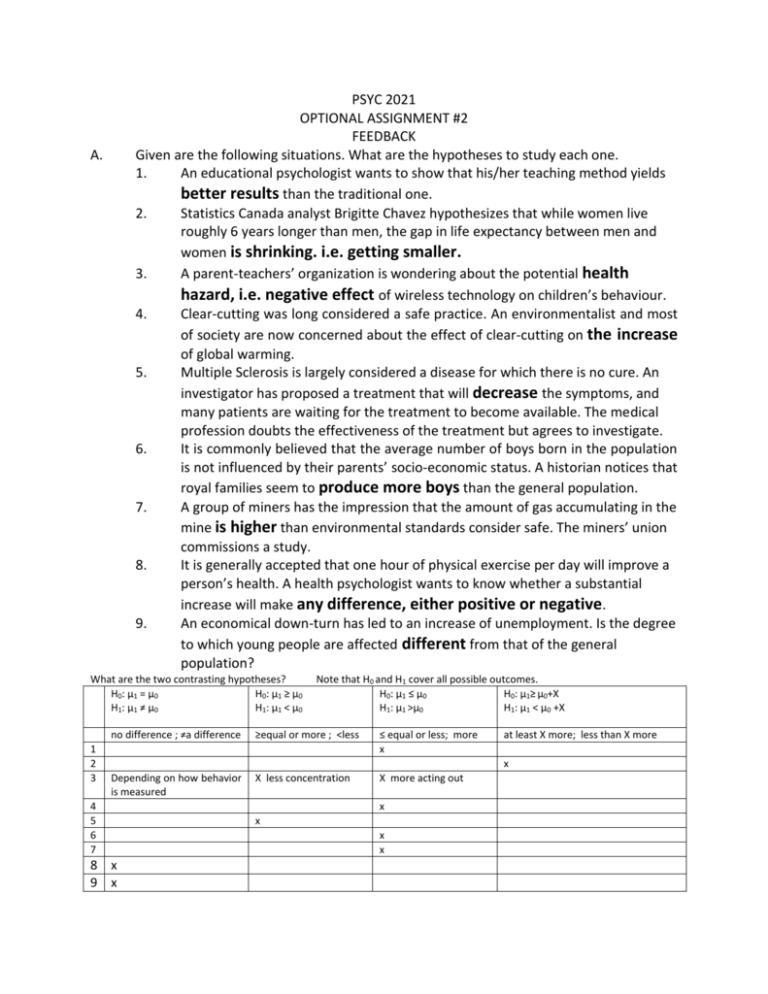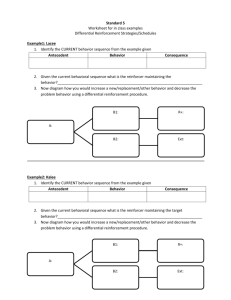Assignment #2 Answers and Feedback
advertisement

PSYC 2021 OPTIONAL ASSIGNMENT #2 FEEDBACK Given are the following situations. What are the hypotheses to study each one. 1. An educational psychologist wants to show that his/her teaching method yields better results than the traditional one. 2. Statistics Canada analyst Brigitte Chavez hypothesizes that while women live roughly 6 years longer than men, the gap in life expectancy between men and women is shrinking. i.e. getting smaller. 3. A parent-teachers’ organization is wondering about the potential health hazard, i.e. negative effect of wireless technology on children’s behaviour. 4. Clear-cutting was long considered a safe practice. An environmentalist and most of society are now concerned about the effect of clear-cutting on the increase of global warming. 5. Multiple Sclerosis is largely considered a disease for which there is no cure. An investigator has proposed a treatment that will decrease the symptoms, and many patients are waiting for the treatment to become available. The medical profession doubts the effectiveness of the treatment but agrees to investigate. 6. It is commonly believed that the average number of boys born in the population is not influenced by their parents’ socio-economic status. A historian notices that royal families seem to produce more boys than the general population. 7. A group of miners has the impression that the amount of gas accumulating in the mine is higher than environmental standards consider safe. The miners’ union commissions a study. 8. It is generally accepted that one hour of physical exercise per day will improve a person’s health. A health psychologist wants to know whether a substantial increase will make any difference, either positive or negative. 9. An economical down-turn has led to an increase of unemployment. Is the degree to which young people are affected different from that of the general population? A. What are the two contrasting hypotheses? H0: µ1 = µ0 H0: µ1 ≥ µ0 H1: µ1 ≠ µ0 H1: µ1 < µ0 1 2 3 Note that H0 and H1 cover all possible outcomes. H0: µ1 ≤ µ0 H0: µ1≥ µ0+X H1: µ1 >µ0 H1: µ1 < µ0 +X no difference ; ≠a difference ≥equal or more ; <less ≤ equal or less; more x Depending on how behavior is measured X less concentration X more acting out at least X more; less than X more x 4 5 6 7 8 x 9 x x x x x B. a. b. c. d. 1 2 3 4 5 6 7 8 9 In each of the situations above, what would a Type I error consist of and who would bear the cost? What would a Type II error consist of, and who would bear its cost? Note that these questions can only be answered through careful analysis and not through superficial guessing. When considering each of these situations, remind yourself of what is a Type I error (rejecting a Ho that is actually true)? what was the Ho in this particular case? What is the concrete consequence of rejecting the Ho in each of these cases? Who is affected by the consequence and how? Go through the same analysis with regards to a Type II error. TYPE I ERROR waste resources on ineffective method; financial cost to school board Waste of resources searching for factors that do not exist Unnecessarily restricting access to wireless technology, opportunity cost to user Unnecessarily restricting access to resources and jobs; economic cost affecting present Waste of resources on ineffective treatment; Cost to health system Introduction of faulty information; possibly waste of money for useless investigation Unwarranted attention to an issue that is of no consequence; waste of resources Unwarranted attention to a factor that is of no consequence. Waste of concern for a population that is no better or worse off than the rest TYPE II ERROR Children miss out on improved method Missing out on important influences on life expectancy Missing out on early detection of health hazards, long-term cost to user and society Missing out on opportunity of environmental protection; long term cost economy & health Missed opportunity to improve condition; Cost to patient Missing out on some nifty piece of knowledge cost to the intellectually curious Missing out on a condition that signals hazard when attention to it could save lives Missing out on factors that influence health Overlooking factors that present a problem to a particular population C. Why are scientists preoccupied with alpha (the probability of a Type I error) and not with beta (the probability of a Type II error? Two reasons: (1) In scientific investigations a Type I error introduces misleading information which then becomes very hard to eliminate; Type II errors tend to be eliminated sooner or later provided the error is reversible. (2) The probability of a Type I error can be known from the z- or t-formula since µ0 is known; the probability of Type II error can only be known when H 0 is rejected and the probability of a Type II error = 0. D. What factors influence the power of a statistical hypothesis test? (1) the alpha-value chosen, (2) whether test is 1-tailed or 2-tailed, (3) the size of σ or ŝ, (4) z or t, (5) N E. What is a point estimate and how does it differ from a confidence interval? A point estimate is a single value (X ̅); the confidence interval also provides the extent to which µ can differ from X ̅, on the basis of (1) ŝ, (2) N and (3) α which determines t; α = 1 – C amount of confidence F. How is the size of the confidence interval influenced by N? The size of the confidence interval is influenced by N since the confidence interval = X ̅ ± ŝxbar x t, where the estimated standard error of the mean ŝxbar = ŝ∕ √N.








